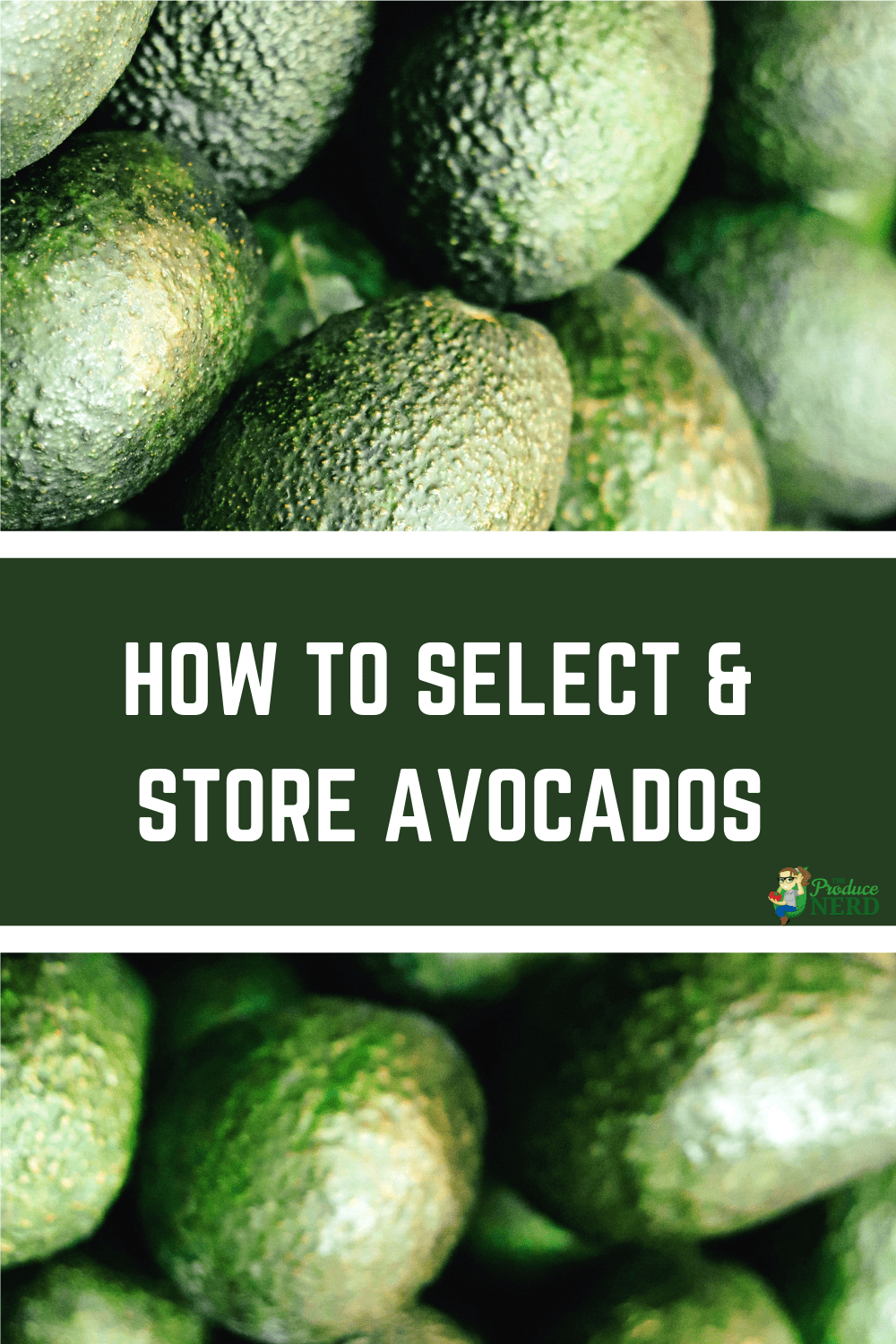Who doesn’t love avocados?! If you aren’t jumping for joy at that question, it might be because you have opened up a few bad ones before, but there is no need for that! This post is all about how to select and store avocados in order to be able to enjoy them to their fullest.
(This post is an excerpt from The Produce Nerd’s Grocery Guide, with input provided by Rachael Laenen from Kimball Avocados. You can learn more about the Grocery Guide, which covers this information for 55 different produce items, with input from 26 crop-specific companies HERE.)
How to pick the best quality avocados?
- Look for an avocado that is firm all the way around without any shriveling at the neck. Check the stem for any signs of mold.
- Most avocados arrive in the grocery store pre-ripened, so they should already be on their way to yielding to slight pressure. Hass is the most widely available variety and will be green and hard with knobby skin before turning black and dull as it ripens.
Common issues to avoid when selecting avocados?
- Shrinkage or shriveling is a bad sign – usually indicating the fruit was picked too early or won’t ripen properly.
- Avocados are clipped from the tree so they should have a little button at the stem. Look for that, as it will help keep anything from getting to the flesh of the fruit.
- Your best friend is going to be paying attention to Country of Origin stickers. Fruit from California or Mexico will give you the best shot at a fruit that will ripen and cut well.
Are there any common issues with avocados that are specifically caused by bad grocery store handling?
- Avocados soften as they ripen, so riper fruit in the stores are more susceptible to bruising. If you can be a little patient, it’s best to buy a hard green avocado and allow it to ripen on your counter at home to minimize the chance of bruising.
Are there any new avocado cultivars that are being grown that might have different quality indicators or common issues to look out for?
- There are TONS of avocado varieties, however Hass is the number one commercial variety. It ships well, ripens beautifully and has the best flavor and creamy texture. The Gem is just coming into the market and has been described as ‘almost as good as a Hass….’! Any green skin varieties have a lower oil content, which will make the flavor watery, the flesh color more pale and can often mean a rubbery texture.
What is the best way to store avocados at home?
- Because avocados do not ripen on the tree (they only start ripening once they’ve been picked), they’re best stored on the counter. Any cold temperature immediately halts the natural ripening process, which, in turn, affects the texture and flavor. Once the fruit is ripe, you can hold it in the fridge until you’re ready to eat it.
Are there any common things that consumers should look for not mentioned above?
- The most widely available avocados will come from Mexico and that’s a good thing! The California avocado sector can’t meet the U.S. demand, but having Mexican fruit means we can have great quality avocados in the market year-round. The California season runs March through September, although quantities are so limited, they barely make it off the west coast. The next best option is to buy Mexican fruit. It travels the shortest distance to be here and their growing season pairs well with ours. Fruit that comes from Chile or Peru is picked much earlier, and arrives by sea freight, so the quality is much more hit or miss.
What is your favorite way to eat and prepare avocados?
- There is nothing better than eating the perfect avocado out of the skin with a spoon! Sprinkle on a little sea salt and that’s all you need. But… the avocado is so versatile! You can use it to bake with – Chocolate avocado cupcakes with avocado frosting anyone?? – or as a mayo substitute in potato salad. And you can’t go wrong with a great bowl of guacamole – a little salt, squeeze of lime, some chile and fresh chopped cilantro. Simple is best to let the true avocado flavor shine through.
A note on organics related to growing avocados:
- I think there are so many misconceptions and a lot of misinformation out there about organics. We grow only conventional fruit because we feel like that allows us to be the most responsible growers possible. We can administer exactly the right amount of nutrients and micronutrients in the right forms at the right times, allowing the tree to easily take up what it needs. Because we know exactly how much nitrogen the tree needs, we put on the exact amount and ensure it doesn’t leech into the groundwater. With organic products, it is much trickier to tell how much nitrogen the tree is grabbing from what is put out, making leeching a big issue.
- The other thing is that we only spray the trees with one pesticide once a year. We have to spray for a pest that got imported to our region. We do use herbicides, however. In a mature orchard, the trees canopy and they create a deep thick leaf mulch which is the very best weed suppression. We only do weed abatement on the roads around the ranch.
If you enjoyed this post, please share it!
Some other articles that may be of interest:

